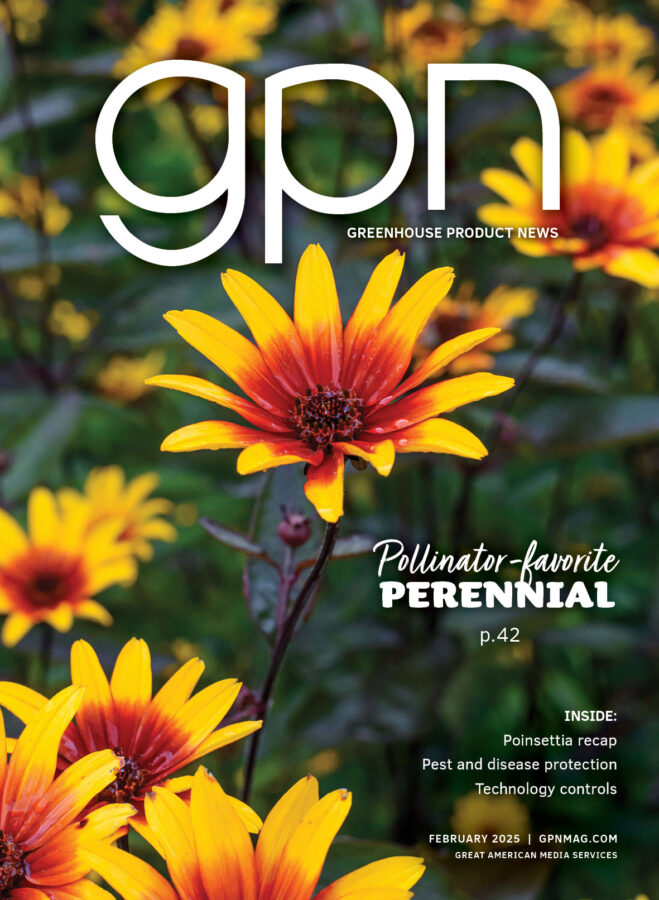
Culture Report: Poco Kniphofia Series
The revolutionary Poco series of red-hot pokers addresses many of the shortfalls of this perennial and opens new opportunities for landscape and container usage. Short bloom-time, unattractive foliage and lack of hardiness were many of the shortfalls of this genus.
Terra Nova Nurseries’ breeders worked overtime selecting crosses that produced the first compact varieties that actually looked great in a container; bloomed from summer till frost; and had stiff, upright, attractive foliage. The plants form ever- widening clumps in the garden and can be used in the landscape in large numbers like a substantial ground cover.
The extended flowering cycle and low maintenance make it an ideal choice for home gardeners and landscapers. Plants are 16 inches tall and wide, and produce flower spikes up to 21 inches tall — perfect for the big-store racks!

Maintenance is minimal, aside from removal of old flower stalks and a spring cut-back. The fact that deer do not find the leaves palatable is another plus. Hummingbirds revel in the profusion of nectar-rich flowers and continue to return again and again for the extended bloom. Pollinators are also drawn to the rich bounty within them.
There are noticeably new flower stalks that push while the plant is in full flower. This is the guarantee of nearly two seasons of bloom. The stiff, grassy foliage is an excellent complement to ivy geraniums or heuchera with their bold foliage.
The plants love the sun and are drought resistant, though they prefer to have regular watering with a drying out period. Southern growers have evaluated these plants as excellent performers in the heat. The growers at Terra Nova Nurseries are equally impressed by the strong growth and adaptability of the plant. Pat Manly, Terra Nova Nurseries’ head grower, was perplexed as to why this genus is not more widely used due to its remarkable performance in his own garden. He also noted that they make fine cut flowers.
Revolutions come and go, but this new series of kniphofia seems like it will be around for a long time, and will create new interest in the genus. As bold blooming machines, these make for extraordinary plants.
AVAILABLE COLORS
‘Poco Orange’ – Bred for very short grassy leaves and a compact habit, and is great for the small garden or for a mass-effect in the border. Flowers are burnished orange with hot red tips.
‘Poco Red’ – Coral-red flowers bloom all summer into fall on this great container or small garden plant. Flowers are nectar-filled and beloved by pollinators, which hummingbirds love.

‘Poco Yellow’ – Sports sulfur-yellow flowers that are produced in profusion and appear all summer through fall. Stout, grassy leaves embrace the bold flower-spikes. Its compact form is great for the front of the border, containers, or in the small garden. It is also popular with the honeybees.
CULTURE
Preferred growing temperature should be between 68 and 72° F. Plugs are grown in 72-count flats and are used one plug per container. Growers will be pleased by the multiple breaks from each plug creating a fuller plant than other varieties. Plants have a thick cuticle, so moderate humidity is adequate and good air circulation is recommended.
A 4-inch pot will finish in six weeks and a gallon pot will finish in eight to 10 weeks. The compact stature of this series allows very presentable, flowering plants in a smaller container. Should larger containers be needed, it is best to grow to a 4-inch pot size and then shift to the larger container.
IRRIGATION
Plants can be sensitive to overwatering. Allow soil to dry between irrigations, even to the point of soft wilt. Poorly draining soil, lack of oxygen or overwatering can cause root rots like Pythium. Drip-through testing should show pH at 5.5 to 6.2. Growing too dry can cause damage to leaf tips.
MEDIA
A well-drained peat/perlite/bark mix is the best. Maintain an EC level of 1.2 to 1.5. A preventative fungicide may be used to prevent Pythium but is usually not required.
FERTILIZATION
Apply a moderate level at 150 to 250 ppm, alternating with clear water. This will help prevent salt buildup and root-burn. Too high of a nitrogen level will encourage foliage production over flower spike production. A 17-5-17 or 20-10-20 formulation is recommended as a liquid feed.
LIGHT
A high light level is recommended for finishing at 6,000 foot-candles. These are long-day bloomers, requiring a photoperiod of 14 hours. Use supplemental lighting such as HID units or high-intensity LED lights when finishing to encourage bloom.
PLANT GROWTH REGULATIONS
No! Never! Plants produce multiple shoots rapidly and are naturally dwarf. Shoot-stimulating treatments are also not necessary as they are naturally prolific. Thank the breeders for saving on labor and expense.
INSECTS AND DISEASE
Aphids may be a problem and some thrip problems may occur while in bloom. Root rot with wet soils can be a problem. It is recommended that the soil dry 1⁄2 to 1 inch below the surface between waterings.


 Video Library
Video Library 



















